2023.12.25infomation
New Year's program: "Wearing Cinema: Yuzen-dyed kimono with film motives”
New Year's program:
"Wearing Cinema: Yuzen-dyed kimono with film motives and the role of Katsutaro Inabata, a major contributor to modern dyeing techniques and the birth of Japanese cinema”
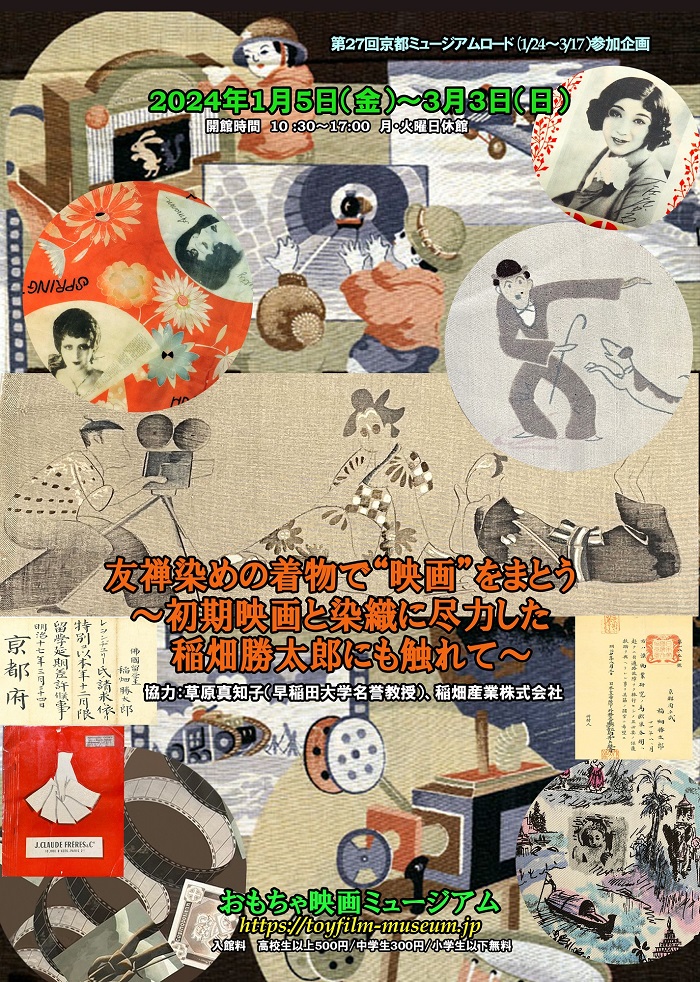
For the first New Year's show, you will be able to see a collection of radiant kimonos and kimono textiles, all with unusual designs depicting film-related paraphernalia, actors and popular characters in cooperation with Professor Emeritus Machiko Kusahara of Waseda University.
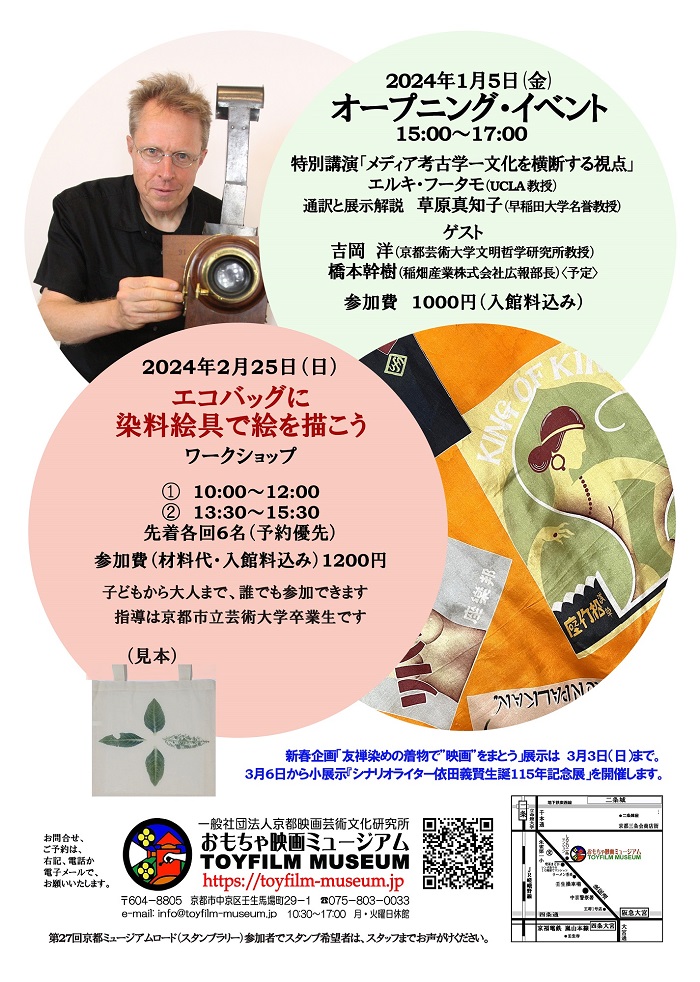
She is the author of the pamphlet 8 "Kimono Patterns Showing Magic Lanterns, Cinema, and Projectors" published by the museum in March last year.
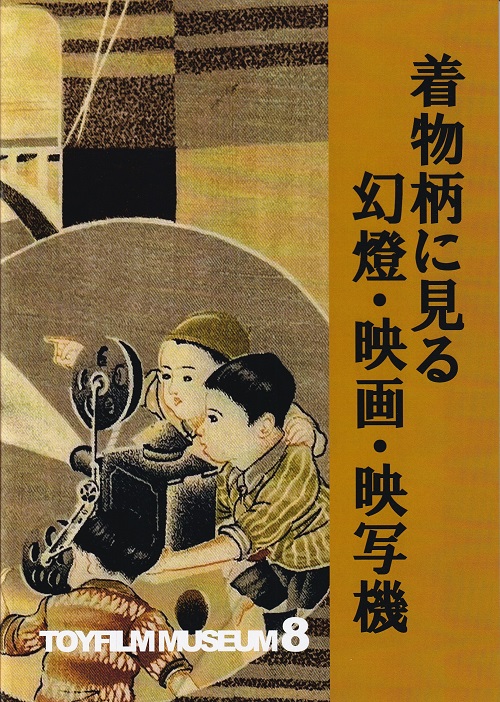
The pamphlet 8 was published on 19 March 2023 together with Booklet 9: Magic Lanterns – Various Ways to Enjoy Them, texts written by Professor Hiromichi Hosoma, Professor of the Faculty of Letters at Waseda University, and Professor Yoriko Iwata, Professor of the Faculty of International Studies at Chukyo University.
To celebrate the publication, all three authors spoke on the day and we also enjoyed a demonstration of the magic lantern. We have been too busy to write a recap, but you can find a brief introduction here./news/infomation/8830.html
This exhibition is the result of a request I made to Prof. Kusahara after the event on March 19. I asked her if we could borrow her kimono collection for the next New Year's exhibition. Since I learned about these “Omoshiro-gara” (interesting patterns) from Prof. Kusahara, the first thing I look for at antique fairs are them. I ask the shopkeepers who deal in old kimonos, but almost no one knows what I mean. These kimono patterns are even more interesting because they are rare. Dr. Kusahara has been collecting them for more than 20 years. The kimono patterns shown in our booklet are just some of them, but they clearly demonstrate that patterned kimonos were a medium that conveyed the trends of the time.
Dr Kusahara wrote a brief description of the exhibition, which is presented below.
......... Children enjoying an animated film on screen, the filming of a costume drama, a film director with a megaphone in hand and a crew with camera and reflector, Chaplin with his dog, film posters, photos of actresses, projectors and cameras, theme songs and original novels from films... Such designs can be found from kimono fabrics. Little is known about the many people who “wore films as kimonos” around 1930, the time when people were enthusiastic about the coming of talkies. Most of these kimono fabrics were Yuzen, designed and dyed in Kyoto, which was also the center of Japanese film production at the time. Such culture of designing and wearing clothes made of fabrics based on topical matters, stories and concrete objects is not found in the West. These kimonos and pieces of cloth are part of Japan's unique design history. The cross-media culture of the time has been largely forgotten. The surprisingly rich visual and musical culture that existed before the war may be seen in this exhibition. ............
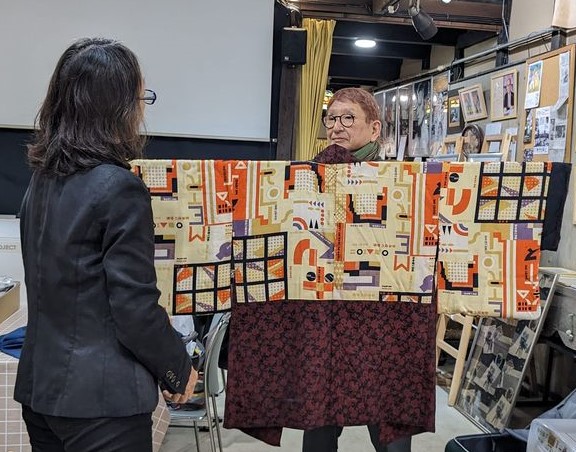
On December 15, Dr. Kusahara visited us. We had a meeting about the exhibition and discussed how to display the works. Please come and see the results, which will be on display until March, 3, 2024, one of the five festivals of the year, the Girls’ Festival day.
Incidentally, in last October I found a woman’s cloak in a photo. It has a lining depicting Fritz Lang's Metropolis, a film about a futuristic city 100 years after its production in 1926 and release in 1927. Soon we will reach that year. The near-future city where robots and humans live together is gradually becoming a reality. I am sure the film attracted a lot of attention when it was released in Japan, because it was promptly depicted in the kimono pattern.
At just the right time, Prof. Erkki Huhtamo, a well-known UCLA professor in the world of media archaeology, is coming to Japan. He will give a special lecture on "Media archaeology - cross-cultural perspectives" on January 5, 2024 at the opening event of the exhibition. We would like to thank him for his willingness to accept the invitation.
Here is Professor Erkki Huhtamo's biography, translated by Professor Kusahara.
............ Professor Huhtamo is one of the founders of media archaeology. His book “Media Archaeology - For Dialogue in the Past, Present and Future” was published in Japan by NTT Publishing, IN 2015. He has visited Japan numerous times and is highly interested in Japanese culture. Born in Finland, he holds a Ph.D from the University of Turku and has worked internationally in the fields of media culture and media art,. writing, lecturing, curating exhibitions, giving demonstrations and directing TV productions. He is currently a professor at the Departments of Design Media Arts and Film, Television and Digital Media at the University of California, Los Angeles (UCLA). He is the author of numerous books and articles, including Illusions in Motion: the Media Archaeology of the Moving Panorama and Related Spectacles (2013, MIT Press). He is currently under contract with the MIT Press for two new books, “Fairy Engine” and “Gadget Head”. He is also working on a large book on the history of mechanical theaters.............
The interpreter will be Dr. Kusahara, who will also talk about the exhibits. And at the invitation of Dr Huhtamo, Dr Hiroshi Yoshioka, currently Professor at the Institute for Philosophy and Science of Art, Kyoto University of the Arts, will provide a commentary on the talk.
The exhibition also touches on Katsutaro Inabata (October 30, 1862 - March 29, 1949), who had a major influence on the spread of yuzen dyeing, which blossomed in Kyoto and eventually influenced other regions to flourish.
Katsutaro Inabata was born as the eldest son of Risuke and Mitsu Inabata, the proprietors of Kameya Masasige, a confectionery shop favored by the Imperial Family, located on the southeast corner of Karasuma Oike, Nakagyo-ku, Kyoto, today. Katsutaro, who was a brilliant boy, was selected by the French doctor Léon Dury as one of eight students to be sent to Lyon by Kyoto Prefecture in 1877 (10th year of the Meiji era). At the age of 15 he studied the basics of dyeing and weaving techniques at the Écoles de La Martinière in Lyon. He then spent three years learning the techniques in the rigours of the Marnasse dyeing factory before studying chemistry at the Université de Lyon.
Inabata returned to Japan in 1885 and worked for the Kyoto Prefectural Government, where he also served as an instructor at the Kyoto Dyeing and Weaving Institute. Two years later, he helped found the Kyoto Textile Company and became its chief engineer, working to spread the use of Western-style state-of-the-art dyeing and weaving techniques.
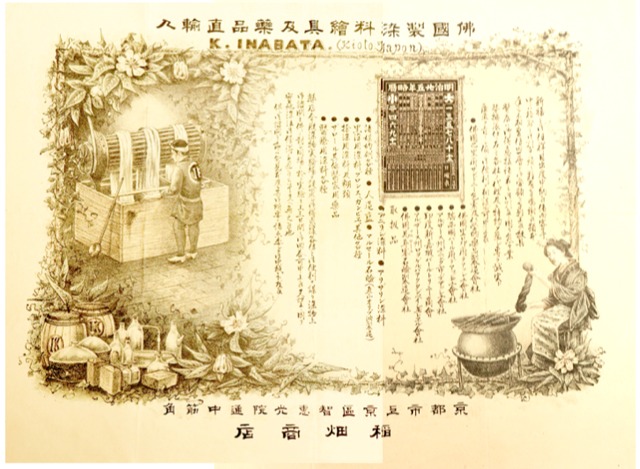
In 1890 (Meiji 23), the Inabata Dye Shop was opened in Kyoto as the sole agent of the French dye manufacturer Saint Denis, and engaged in the direct import trade of synthetic dyes. (The advertisement above was found on the internet. It would be interesting to know if anyone has an actual copy.)
In 1895 (28th year of Meiji), Inabata founded the "Muslin Spinning and Weaving" company with the aim of producing muslin domestically. The following year, 1896 (29th year of Meiji), he travelled to France to buy machines for muslin production, where he met again with Auguste Lumière, a friend from his time of studies in Lyon, and was surprised to see the cinematograph he had invented with his brother Louis Lumière. Inabata thought it would be the best way to introduce the Japanese people to the latest Western culture using state-of-the-art optical equipment, so he invested a huge sum of money to bring it back to Japan in January the following year, together with the Lumière Brothers’ cinematographer and projectionist, Constant Girelle.
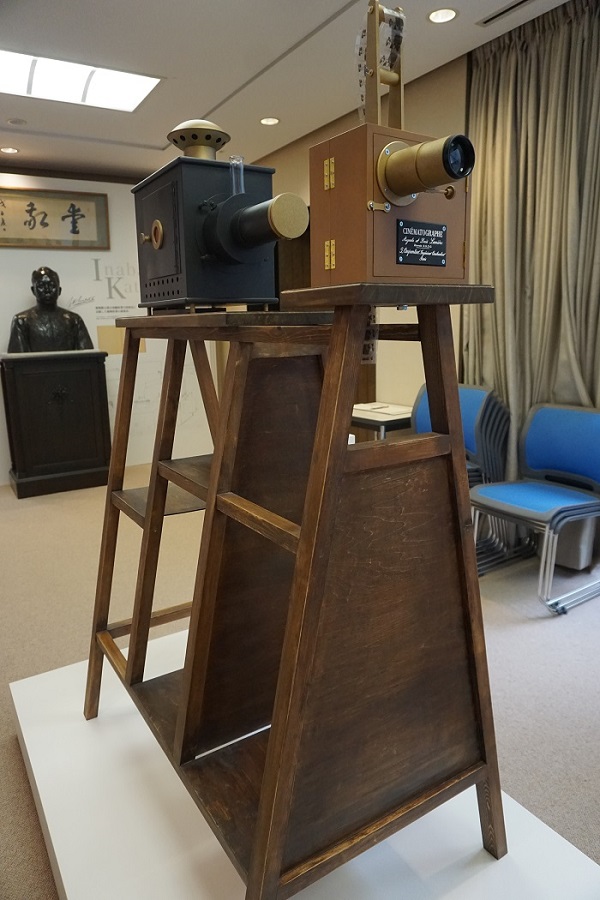
There is a replica of the cinematograph in the 'Founder's Archives' of Inabata Sangyo K.K. (photo taken on November24, 2023). Inabata conducted a trial projection experiment as soon as possible in 1897 in the garden of Kyoto Dento Co Ltd (i.e. Kyoto electric light company) which was located on the site of the current Rissei Garden Hulic Kyoto. He continued efforts to overcome problems through repeated trial and error, and in February of the same year, the first film exhibition (paid screening) in Japan was held at Osaka's Nanchi Enbujo.
In addition to fierce competition from other companies in the industry that jumped at the chance to try something new, Inabata also had to deal with the troubles related to the early film business. He handed the business to Yokota Masunosuke, who was his colleague student in Lyon sent by the Prefecture, and Yokota’s brother Einosuke, and returned to his core business in the textile industry, away from the cinema. For more information on what happened during this period, please watch the video of a lecture given by Surugadai University professor Kenichiro Hase on 22 May last year in Part 1 of the series 'The Men Who Brought Films to Japan'.https://www.youtube.com/watch?v=QlFKwjXHQLc
In 1897, he established the Inabata Dyeing Factory in Osaka and entered the dyeing and processing industry using the latest technology. The 'ebi-cha brown' colour was then known as 'Inabata dyeing', and was used for the hakama-skirts of girls' school uniforms. During the Russo-Japanese War the company contributed to the nation by inventing 'khaki dyeing' for military uniforms. Inabata Company made great strides by concentrating on its core business away from the film industry, including the opening of a series of overseas offices.
In 1916, the government established Japan Dyestuffs Manufacturing Co., Ltd. in Osaka to promote the domestic production of dyes, and in 1926, Inabata, who had been involved in the company's establishment as an auditor, was appointed president. The developments that followed were spectacular, but just looking at the early years, you can see that Katsutaro Inabata was not only instrumental in introducing cinema to Japan. He was also a key figure in the dyeing and weaving industry.
At the exhibition, the sample book of the latest fabrics of the time and other materials imported from France for the sale of dyes will be on loan from Inabata Sangyo K.K.. Mr. Motoki Hashimoto, Director of Public Relations, who made the effort to exhibit the materials, will join the opening event on January 5, unless he is kept too busy with his business.
A reception, which has long been postponed by the Covid Disaster, will be held on the 5th, following the special lecture, to celebrate the start of the new year and to enjoy chatting for the first time in a long time. The participation fee is 1,000 yen (including entrance fee). It would be a great help to our preparations if you could register in advance. Thank you for your cooperation.
On February 25, during the exhibition, a workshop will be held to draw pictures on plain eco-bags using dye paints in connection with the exhibition, as the museum was originally home to a Kyoto Yuzen stencil dyeing workshop. There will be two sessions, one at 10.00 am and the other at 13.30 pm. They will be available for the first six people to arrive each time. Please make a reservation if at all possible to avoid a disappointment. The workshop will be conducted by three graduates of the Kyoto City University of Arts.
One more thing: this exhibition is a participating project of the 27th Kyoto Museum Road: from January 24 to March 17. If you apply by stamping three different stamps on a special postcard at participating museums in the stamp rally, you will be entered into a draw for goods provided by the various museums. Please take part in the event to improve your health and to stimulate your intellectual curiosity! We look forward to seeing you at the museum.


